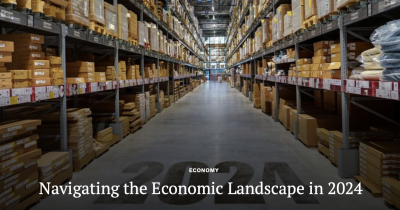
Article originally published in Tomorrow’s Affairs
As we embark on the year 2024, the economic landscape is characterized by a blend of factors, including declining but still elevated inflation, potential interest rate cuts, increasing geopolitical risks, and soaring public debt.
The final quarter of 2023 witnessed a remarkable improvement in market sentiment. The moderation of inflation, strong corporate profits that exceeded expectations, and optimism regarding impending rate cuts all contributed to this surge.
The heightened complacency, evident in the “extreme greed” levels on the CNN Greed and Fear Index, resulted from aggressive rate reduction expectations by central banks and projections of a swift decline in inflation. However, as we move into 2024, parallels with the preceding year become apparent.
Contrary to market expectations, a “soft landing” is not enough to bring about the anticipated year of disinflation; a recession is the necessary catalyst.
An abrupt increase in the global money supply, standing at nearly $107 trillion by the end of the year, remained a bulwark against a recession in 2023, coupled with relentless government spending.
A lag effect
The contrast between alleged tight monetary policy and active fiscal measures has placed the entire negative impact on the private sector, bearing the brunt of rate hikes and declining monetary aggregates.
A manufacturing sector that remains in deep contraction is joined by a services sector that sees how consumers have almost depleted their savings for 2021.
Although inflation declined alongside monetary aggregates, the economic repercussions have been delayed due to a lag effect.
The full-scale impact of the 2023 monetary contraction is expected to manifest in 2024
The full-scale impact of the 2023 monetary contraction is expected to manifest in 2024, leading to a decline in inflation if the economy falters and private sector demand recedes.
However, the notion of a quick slump in inflation with no impact on growth or jobs appears increasingly implausible. Additionally, a looser monetary policy may contribute to commodities rebounding, attracting freshly printed money towards unconventional assets, and making the inflation decline more challenging.
The impact of debt and public spending remains a critical consideration. Will central banks uphold market support? How will taxes and macroeconomic factors shape the global economy? These questions underscore the delicate balance between recovery and potential risks.
A year of stagnation
In 2024, a prudent investment policy is recommended. Central banks are expected to maintain accommodative policies, injecting liquidity selectively. However, anticipated interest rate reductions may not be as significant as expected.
The global economy enters 2024 with less uncertainty. Geopolitical risks seem to have been discounted, and this may be a sign of excessive optimism in a year where global growth is projected to slow markedly, while the Eurozone and Latin America may continue to show worse growth than their counterparts.
2024 will likely be a year of stagnation with elevated public debt
Strong China and India growth will not likely change the weak trend of productivity and growth generated in most developed and emerging economies after years of debt-fueled government spending programs.
2024 will likely be a year of stagnation with elevated public debt. Thus, the expected quantitative tightening is likely to be less severe with a rising global money supply and improved credit conditions.
A risky environment for fiat currencies is anticipated, with ongoing destruction of the purchasing power of the domestic currencies as governments continue to increase their fiscal imbalances.
Gold and bitcoin may help citizens avoid the debasement of currencies without ignoring the large difference in volatility of each asset class.
Global loss of purchasing power is likely to continue even with declining annual rates of rise in consumer prices, with expected global inflation between 3.5% and 4%
Expectations of large rate cuts and even quantitative easing from the Federal Reserve may be too optimistic. In a U.S. election year, substantial changes in monetary policy are not anticipated.
As such, global demand for dollars is expected to rise, creating a favorable environment for dollar-denominated assets.
Numerous risks cast shadows on the economic horizon, including more persistent inflation, unanticipated impacts on business margin and profits, potential currency depreciation in emerging markets, the ongoing China-USA trade conflict, the war in Ukraine and Israel generating widespread geopolitical risk, and the spectre of a black swan event in the debt market causing a credit crunch.
2024 is likely to be very similar to 2023. The long-term trends of weak productivity and GDP growth, high debt, rising government size in major economies, increases in taxes, and erosion of the purchasing power of salaries and savings will continue.
Equities may react positively to looser monetary policy, but the macroeconomic path to stagnation remains.


